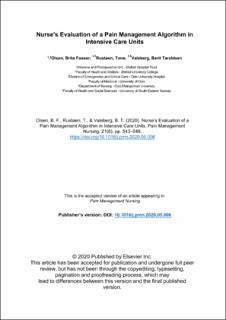Nurse's Evaluation of a Pain Management Algorithm in Intensive Care Units
Original version
Olsen, B. F., Rustøen, T., & Valeberg, B. T. (2020). Nurse’s Evaluation of a Pain Management Algorithm in Intensive Care Units. Pain Management Nursing, 21(6), 543-548. https://doi.org/10.1016/j.pmn.2020.05.006Abstract
Background: Many patients have memories of pain during intensive care unit stay. To improve pain management, practice guidelines recommend that pain management should be guided by routine pain assessment and suggest an assessment-driven, protocol-based, stepwise approach. This recommendation prompted the development of a pain-management algorithm. Aim: Evaluate the feasibility and clinical utility of this algorithm. Design: A descriptive survey. Settings: One medical/surgical intensive care unit, one surgical intensive care unit, and one postanesthesia care unit at two hospitals in Norway. Participants/Subjects: Nurses working at the three units. Methods: A pain-management algorithm, including three pain assessment tools and a guide to pain assessment and pain management, was developed and implemented in three intensive care units. Nurses working at the three units (n = 129) responded to a questionnaire regarding the feasibility and clinical utility of the algorithm used. Results: Our results suggested that nurses considered the new pain-management algorithm to have relatively high feasibility, but somewhat lower clinical utility. Less than half of respondents thought that pain treatment in clinical practice had become more targeted using the tree pain-assessment tools (45%) and the algorithm for pain assessment and pain management (24%). Conclusions: Pain-management algorithms may be appropriate and useful in clinical practice. However, to increase clinical utility and to achieve more targeted pain treatment, more focus on pain-treatment actions and reassessment of patients’ pain is needed. Further focus in clinical practice on how to implement an algorithm and more focus on pain-treatment action and reassessment of patients’ pain is needed.

